Articles about maps
History of cartography
All about topographic maps
Topographic maps and traveling
Two centuries of Russian Cartography
Navigation software and offline maps
Topographic maps and traveling
Altai region
Bicycle touring routes and topographic maps
Bicycle tourism in Crimea
Bycling touring and topographic maps
Carpathian mountains
Caucasus Mountains
East Sayan Mountains
Kamchatka region
Lake Baikal
Olkhon - the heart of Baikal
Plateau Putorana
Rafting and topographic maps
Rafting directions and topographic maps. Part 1
Rafting directions and topographic maps. Part 2
Topography of China
Kamchatka region
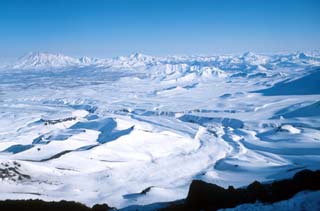
The territory of the whole Kamchatka and its region is one of the richest natural and recreational resource. Thermal and mineral sources, volcanoes and glaciers of Kamchatka, the famous Valley of geysers, very multifarious, mostly untouched flora and fauna make big possibilities for the development of ecological tourism, sport fishing, alpine skiing tourism and mountaineering.
There are two state preserves, 17 state reserves, 169 unique nature objects, including nature memorials, five natural parks. 27% of the whole territory of Kamchatka is referred to protected category. Five nature territories of the region of Kamchatka are joined the List of World-wide culture and nature heritage, unified by the general name “Volcanoes of Kamchatka”.
The peculiarities of the nature in Kamchatka
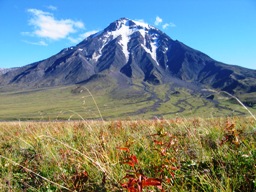
Such nature phenomena as immense mountain ranges with plenty of extinct or fire-splitting volcanoes, numerous hot and cold mineral wells, geysers, fumaroles, situated in picturesque valleys, surrounded by mountains with topping to the sky peaks, covered with snow and with green slopes and alpine fields are belonged to the recreational potential of Kamchatka, to exotic objects and peculiarities of Kamchatka. Kamchatka is rarely rich in water resources: there are more than 1400 rivers and brooks, about 100 000 big and small lakes, 414 glaciers with general square 871,1km2. There are 29 active and about 150 extinct volcanoes, 274 mineral spring, 160 of which are thermal, 37 species of wild animals and all the types of pacific salmon on the territory of Kamchatka. Forests of Kamchatka are full of berries, ramsons. In wild places there are lynxes, wolverines, beavers, lots of furry animals and game.
Volcano Klyuchevskoy

Volcano Klyuchevskoy is the biggest active volcano of Eurasia. Its height is 4750m above the sea-level. The volcano has practically perfect, extraordinary beautiful cone and together with Kamen, Bezymianny, Plosky Tolbachik and others is included in the Klyuchevskaya group of volcanoes. The age of the volcano is about 8000 years. The first eruption was stated in 1697 by Vladimir Atlasov during his famous trip. In general the eruption of the volcano happened once in five years, in some definite periods it happened annually and sometimes it was lasting for years. But the volcanoes have never been dangerous to the town Kluchi, which is 30km far from them. Eruptions are accompanied by explosions, gas emissions and ashes-falls. The heaviest eruptions of the volcano Klyuchevskoy, for instance in 1944-1945, came from the main centre crater, but the presence of “false” craters, the height of which is from 60 to 200 meters and which are detached from the main one from 8 to 25 km is also typical for the volcano.
The first climb to the Klyuchevskoy volcano was carried out by a mountain guide Daniel Gaus in 1788. Since then only few persons reached the crater of the mountains.
Volcano Maly Semyachik
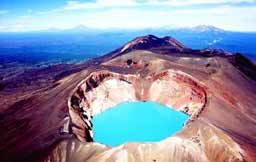
Maly Semyachik is a volcanic ridge of 3 km lengthwise, at which there are three craters. In the southern one (crater Troitskogo) there is an unusual acid-lake at the depth of 170 meters. The temperature of the opaque lake is about from +27С to +42С and the level of mineralization is in the proportion to the mixture of sulphuric and hydrochloric acids of small concentration. The sizes of the lake are also amazing: the width is about a half of kilometer and the depth is up to 140 meters. The acid-lake is considered to appear comparably recently as a result of the eruption, which happened imperceptibly for people. Nowadays Maly Semyachik is one of the miracles of the nature in Kamchatka and people, who managed to get to its foot, should get to the edge of the crater. The view is unforgettable: there is two-hundred meters hole of the crater, green lake, variety of colors on inner walls. In sunny weather it’s possible to get down to the crater. You can stand on the beach enjoying the emerald wash and waterspout-like "genies", rising above the surface of the lake. But the lakeside breeze, provoking cough, will make you soon leave the place of underground “spirits”.
Volcano Gorely
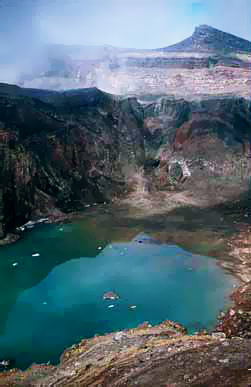
Volcano Gorely, which presents as a chain of 11 craters with lakes, fumaroles, great number of secondary scoria cones with lava-streams (about 40); at outcrops of the sides of its ancient structure you can learn the processes of volcanoes formation, including the formation of pyroclastic materials, sintered tuffs and ignimbrites. Volcano Gorely is an outstanding geological object.
Volcano Karymsky
Volcano Karymsky is comparably small (1486m.) and comparably young volcano (6100 years), but it is the most active volcano of Kamchatka. Only in XX century 23 eruptions happened, the last one began in 1996 and, slowly dying out, was lasting for more than two years. Eruptions of the volcano Karymsky are accompanied with explosions, ashes emission and bombs from the central crater. As a rule, the lavas of Karymsky volcano are so viscous, that fiery-streams don’t always reach the foot of the volcano.
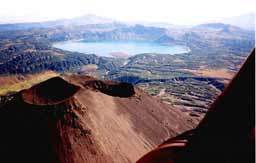
The last eruption of the volcano was different because at the same time began underwater eruptions in the Karymsky Lake, which is situated 6 km far from the volcano. While the eruptions of the Karymsky volcano lasted, more than 100 underwater explosions accompanied it with waves of “tsunami”, which had the height of 15 meters. The lake boiled: its temperature harshly rose and salt and acids content quickly reached such a concentration that all the lacustrine life died. As a result of Karymsky eruption the lake from a sweet reservoir became the biggest nature reservoir with acid water.
Coasts of the peninsula, abruptly breaking by cliffs or splitting into beautiful bights and bays, where rivers with crystal water fall in, where on benches of rocks hundred thousands sea birds nest, sea-eagles all these can’t leave you indifferent. On numerous rocky little islands along the coasts of Kamchatka a lot of walruses, seals, fur-seals, sea-apes, rest, and in the coastal waters of Kamchatka dolphins and white whales frisk, marvelous whales swim. A big number of nature memorials such as unique resources, waterfalls, rocks, volcanoes, islands with lots of birds, lakes and fiords, mountain ranges and tracts in Kamchatka region will always attract tourists, who love nature.
Active volcanoes, mountain ranges and mountains with the height of more 3000 – 4000m, littoral waters, historical memorials, will arouse interest to Kamchatka from the side of foreign tourists, mountaineers, bird lovers, animals, plants and all the diversity of the untouched nature.
Kamchatka map set is available for purchasing.



